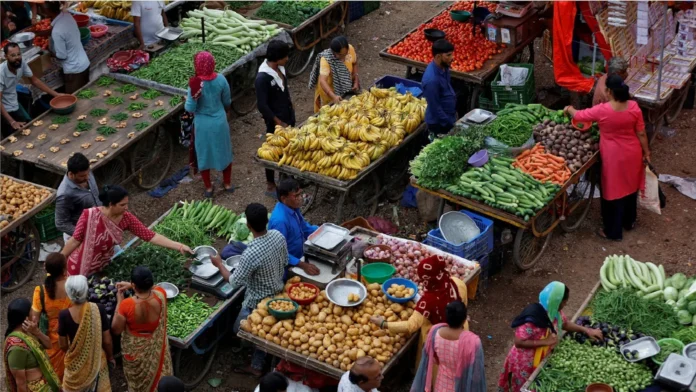Food Price Volatility Looms as Major Threat to India’s Inflation Control, Central Bank Warns
India’s headline inflation is projected to average around 4.5% in the second half of the fiscal year, largely benefiting from weaker crude oil prices. However, the Reserve Bank of India (RBI) has warned that volatility in food prices could pose significant risks to inflation stability. In its monthly bulletin released on Friday, the RBI noted that while some of the price surges seen in vegetables have started to subside, the ongoing uncertainty surrounding food prices remains a critical factor.
The central bank highlighted that the first quarter of the 2024-25 fiscal year was marked by persistent food inflation, particularly driven by spikes in vegetable prices. “Some vegetable price shocks have begun to reverse, and if this trend continues and expands, we may have left the worst behind in terms of food inflation,” the RBI commented.

Retail inflation in India was recorded at 3.65% in August, slightly higher than the revised figure of 3.60% in July. The rise was largely attributed to a sharp increase in vegetable prices, a major component of food inflation. Food prices, which contribute nearly 50% to retail inflation, climbed by 5.66% in August, up from 5.42% in July.
The RBI aims to maintain inflation at a target of 4%, with a tolerance band of two percentage points on either side. However, it expressed concern that an unfavorable base effect could impact September’s inflation data, potentially causing a rise in inflation figures for that month.

Despite the challenges posed by food price volatility, the RBI remains optimistic about household consumption in the near term. The bank projects faster growth in household consumption for the July-September period as overall inflation eases. This anticipated increase in consumer spending could provide a boost to the broader economy, though it remains contingent on continued stability in food prices and broader inflation trends.
The RBI has maintained a cautious stance on monetary policy. In August, it left its key interest rate unchanged for the ninth consecutive meeting, reflecting a measured approach to easing monetary policy. The next monetary policy meeting is scheduled for October 7-9, and analysts expect the RBI to proceed cautiously in the face of ongoing inflation risks.
Additionally, the RBI noted a positive development in the banking sector, where the gap between banks’ credit and deposit growth is starting to narrow. However, it also pointed out that banks are increasingly relying on certificates of deposit to meet their funding needs. This trend signals some liquidity constraints in the banking system, though not at an alarming level.
Non-banking financial companies (NBFCs) have also been facing challenges, particularly regarding asset quality. The RBI reported that NBFCs are increasingly turning to offshore bonds to meet their funding needs, but microfinance institutions (MFIs) are encountering asset quality issues, prompting them to slow down loan growth.
In a separate article in its bulletin, the RBI emphasized the need for NBFCs to stay vigilant in the face of evolving financial risks. The central bank underscored the importance of proactively identifying and managing risks, particularly in areas such as cybersecurity and climate risks. NBFCs are urged to strengthen their risk management and assurance functions to ensure financial stability in the long run.
The bulletin also pointed to the growing importance of NBFCs in India’s financial system. As they expand their market presence, it becomes crucial for them to adapt to the rapidly changing financial landscape and manage the associated risks effectively. The RBI highlighted that the resilience of NBFCs is essential to maintaining overall financial stability in the country, given their significant role in providing credit to sectors that are often underserved by traditional banks.
In conclusion, while India’s inflation outlook for the second half of the fiscal year appears stable at around 4.5%, food price volatility remains a critical challenge. The easing of crude oil prices provides some relief, but the central bank remains cautious about the potential for further food price shocks. The RBI’s upcoming monetary policy decisions will be closely watched, particularly in the context of inflation trends and the broader economic outlook.
At the same time, the financial sector, particularly NBFCs, faces evolving risks that need to be managed carefully. With ongoing asset quality concerns in microfinance institutions and increased reliance on offshore funding, NBFCs must adapt to the changing landscape. The RBI’s call for enhanced risk management highlights the importance of financial stability as the sector navigates new challenges, including those related to cybersecurity and climate change.
The Indian economy, buoyed by improving consumption, may see stronger growth in the coming months, but inflationary risks, especially related to food prices, will require continued vigilance from policymakers and financial institutions alike.

